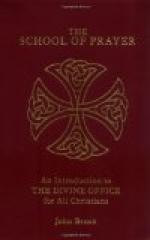“A false kind of patriotism and national pride often go along with credulity, so that we find here and there in literature of this kind, even downright fabrication. After the introduction of printing, by which literature became more widely diffused, and comparative criticism was rendered possible, it at once became evident among Catholics that error was mixed with truth and that a sifting of the one from the other was necessary, and, in many cases, possible” (Kellner, Heorlology, pp. 209-210). “It was not the intention of the Church or of the compilers and authors of the service books to claim historical authority for their statements. And so, the Popes themselves have directed many emendations to be made in the legends of the Breviary, although many others still remain to be effected” (Dom Baumer, Histoire Du Breviare Roman). Cf. Dom Cabrol, Le Reforme du Breviare, pp. 61-63.
Responsories. (Title XXVII.). In the new Breviary the responsories to the lessons have been restored to their place of honour. They are of ancient origin, but “how they came to have a place in the Divine Office, who was responsible for their composition, what was the process of development until they reached their present form, are questions upon which liturgical writers are not quite agreed” (Rev. M. Eaton, Irish Eccles. Record, January, 1915). Amalare of Metz found them fully formed and placed. The rule of St. Benedict, written about 530 A.D., mentions them as a recognised part of Matins. In solemn vigils, in the early Church, the congregation took part in the psalm singing, and hence we find psalmi responsorii mentioned, and we still have a typical instance in the Invitatory Psalm of our Office. Probably, some similar practice existed in the readings from Sacred Scripture. “At those primitive vigils, then, after the reading of the Sacred Scripture, the responsory was given by the precentor and the assembled faithful took up the words and chanted them forth in the same simple melody. Next, a verse was sung frequently echoing the same sentiment, and the choir again, as in the psalmi responsorii, repeated the refrain or the responsorii proper. Frequently other verses were added according to the dignity of the festivals, and after each the faithful struck in with the original refrain.... At first those responsories would probably have been extempore ... left to the genius or to the inspiration of the individual chanter, but gradually, by a survival of the fittest, the most beautiful ones became stereotyped and spread throughout several churches.... Later they were carefully collected, arranged and codified by St. Gregory or one of his predecessors and passed into all the books of liturgy” (Rev. M. Eaton, loc. cit.). Monsignor Battifol (History of the Roman Breviary, Eng, trans., p. 78) says that these parts of the liturgy, in beauty and eloquence rival the chorus dialogues of Greek drama, and quotes as an example the Aspiciens a longe from the first Sunday of Advent.




